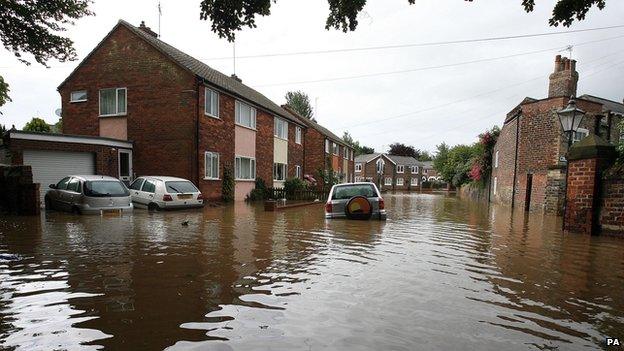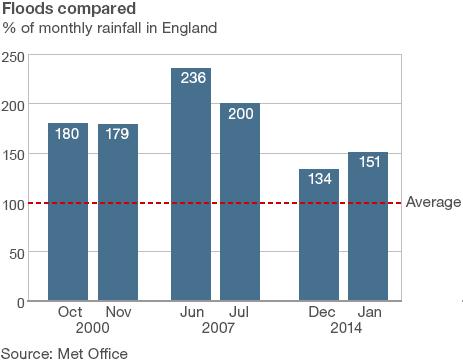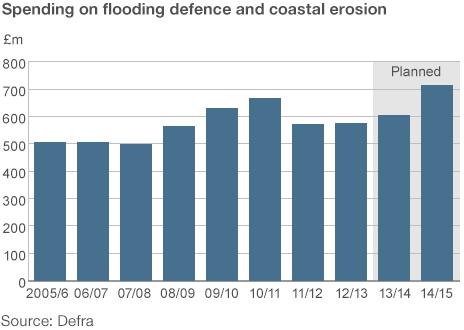UK floods: How bad have these floods been?
- Published

It could be this month, but actually this picture is of Beverley in East Yorkshire in 2007
This year's extreme weather has caused severe flooding in parts of the UK but how does it compare with the floods of 2007 and 2000?
There's definitely been a lot of rain this winter and the relentless bad weather has made it feel considerably worse than previous years.
In terms of rainfall, the figures certainly back up that view. England had the wettest January since records began in 1766 and it appears likely that it will turn out to be the wettest winter overall on record too.
But in terms of damage done, we've seen considerably more in previous years.
Clearly, the bad weather is not yet over, but so far the Environment Agency, external says that since the beginning of December, 5,800 homes and businesses have flooded.
As devastating as flooding is for residents, from a statistical point of view the national scale of the damage is, so far, relatively limited.
In the summer floods in 2007, 48,461 homes were flooded and 6,896 businesses, according to the Environment Agency, external.
The year 2000 saw the wettest autumn on record across the UK, according to the Met Office, external, which says that 10,000 homes and businesses were flooded across 700 locations.
Comparing the amounts of rainfall in the different years is difficult because they were in different seasons.
If you look at the worst-affected areas, the Midlands had 269% of its average rainfall in June 2007, while south-east/central southern England had 258% of its average rainfall last month.

Other indicators may also be significant. Roger Brugge, a meteorologist from the University of Reading, has calculated that in his local area there has been 5mm or more rainfall for 24 days in the past two months.
He says that has only been beaten once in the past 100 years. "There would normally only be two or three such days in a month," he says. "It's the steady drip drip", he suggests, which has caused the damage.
This is in contrast to 2007, when much of the damage was done by one really big storm. But these figures may mask big factors in causing flooding, such as how much water was already in the ground and how cold it was.
Brugge cites the example of the winter of 1947, which was exceptionally cold with some snow. "In early March there were four days with half an inch of rain," he says, but the ground was completely frozen, which was "a bit like having a plastic sheet over the ground".
All the rain ran straight into the rivers and there was extensive flooding, despite only two inches of rain falling.
"This year, each of the [rain] events that we've seen has not been notable but the rainfall accumulation has been exceptional," says Simon Parry from the Centre for Ecology and Hydrology. He points to the figures for the River Thames, which has been above what is regarded as a notable high-flow mark since Christmas Eve, "which is twice as long as any time in the last 130 years".

This year, the rain coming over an extended period has allowed authorities time to repair flood defences and prepare for the next downpour.
"The network of flood defences seems to have performed well over this winter," Parry says. There has been a great deal of spending on flood defences since the last major flooding in 2007.
The Environment Agency says that since the beginning of December, its flood schemes have defended more than 1.3 million homes and businesses and nearly 2,500 square kilometres of farmland across England.
The weather this winter has been almost unprecedented and it seems likely that without the extra defences, the damage would have been more like it was in 2007.
You can follow the Magazine on Twitter, external and on Facebook, external